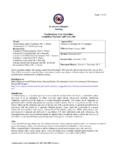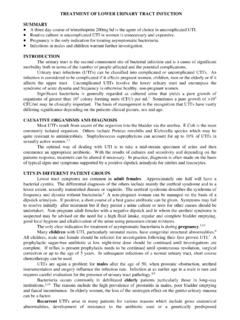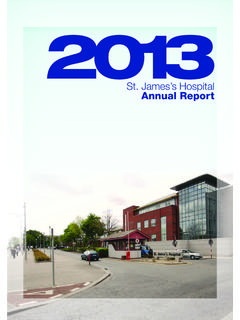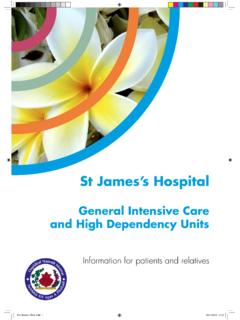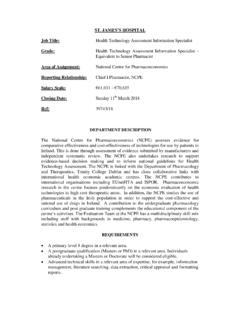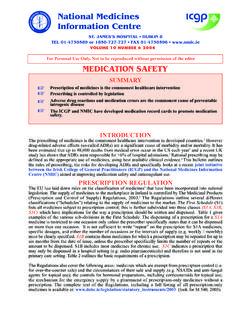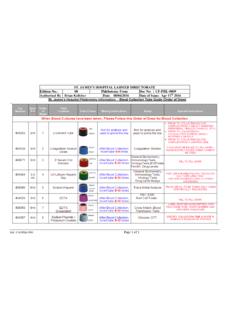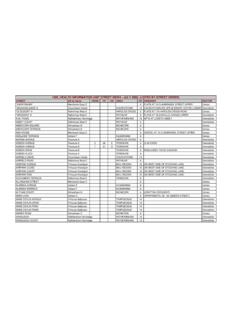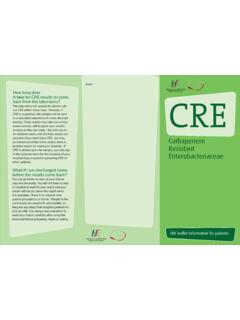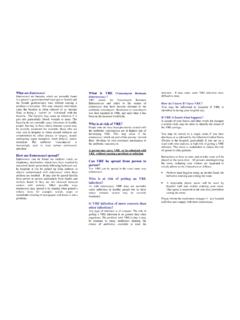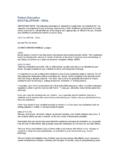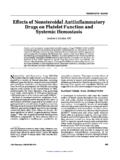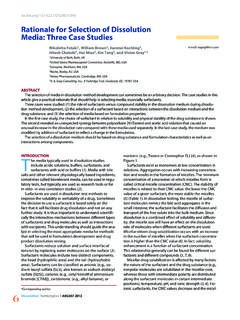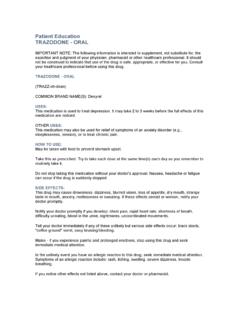Transcription of National Medicines VOLUME 14 Information Centre …
1 INTRODUCTIONM edication use is extensive in developed countries: it has been estimated that approximately four fifths of US adultsuse at least one medication (prescription medicine , over-the-counter (OTC) drug, herbal remedy) per week, and this rateincreases with recent US survey reported an average of medications prescribed or provided per patient study carried out in Ireland noted that, during 2001-2002, up to 45% of patients >70 years were receiving >5concomitant concomitant use of more than one medication leads to the potential for drug interactionwhich is said to occurwhen the response of a patient to a drug is changed by the presence of anotherdrug,food/drink, herbal substance or some environmental is the first of 2 bulletins on drug interactions.
2 It will explain the various ways that a drug interaction may occur,and describe ways of preventing or minimising their impact on the of various prescription databases have reported incidences of potential drug-drug interactions in up to 6% ofpatient records, and potentially serious drug-drug interactions in up to 1% of ,6In a study of 458 US Veterans Administration (VA) patients, 197 people reported taking dietarysupplements in addition to prescriptionmedicines, of which 45% showed a potential forinteraction, mostly importance of drug interactions to the clinician primarily involves knowing or predicting those occasions when apotential interaction is likely to have significant consequences for the patient might lead to (a) reduced or increasedefficacy of the drug(s) involved, (b) increased adverse drug reactions (ADRs) or (c) might even require withdrawal ofone of the ,8 There are well-known risk factors for developing drug interactions (see Table 1).
3 National MedicinesInformation CentreST. JAMES S HOSPITAL DUBLIN 8 TEL 01-4730589 or 1850-727-727 FAX 01-4730596 14 NUMBER 42008 DRUG INTERACTIONS I: HOW THEY OCCUR++++Drug interactions occur more often via pharmacokinetic than pharmacodynamic processesMost clinically important interactions involve altered metabolism of the affected drug(s) in the liverOlder patients and / or those with chronic illness are at increased risk of drug interactionsThe potential for interaction (with a drug, herb or food) should always be considered beforewriting a prescriptionTable 1: Drug characteristics associated with a high risk of interaction4,9 CharacteristicExamplesNarrow Therapeutic IndexDigoxin, warfarin, ciclosporin, aminoglycosides, lithiumSteep Dose-Response CurveSulphonylureas, verapamil, levodopaSaturable hepatic metabolismPhenytoin, theophyllineDosage dependent on patient responseImmunosuppressives, anti-epilepticsCo-prescription with drugs that have a narrow therapeutic index ( where a small margin exists between thetherapeutic and toxic drug levels)
4 Has an increased chance of a clinically significant drug interaction occurring, as hasthe use of drugs with a steep dose-response curve ( a small rise in drug levels leads to a large increase in effect).Drugs with a saturable metabolism are more likely to accumulate in the presence of a drug interaction (Table 1).Careful attention is required when co-prescribing these patient characteristics associated with high risk of drug interactions are outlined in Table 2: Patient characteristics associated with high risk of drug interactions4,10 Increasing ageGenetic predispositionChronic illnessCritically ill patient/ Presence of renal or hepatic dysfunctionNumber of prescribing physiciansUse of multiple co-prescribed +/- OTC drugs (polypharmacy)FOR PERSONAL USE ONLY.
5 NOT TO BE REPRODUCED WITHOUT PERMISSION OF THE EDITORP roblems with absorptionusually involve more than one of the mechanisms outlined in Table 4. Interference withplasma protein bindingwas previously thought to have potentially serious consequences, however it is now understoodthat most drugs, extensively bound to plasma proteins and subject to displacement reactions ( warfarin, phenytoin,methotrexate), have a compensatory clearance system, therefore any increase in free drug is ,9 Thecommonest type of interaction affecting eliminationinvolves change in active renal tubularexcretionof one drug byanother (Table 4).
6 Drug interactions tend not to interfere with biliary 3. Common pharmacodynamic interactions4,12 Type of interactionExamplesPharmacological EffectAdditive/synergisticNSAID + warfarinIncreased risk of bleedingVerapamil + -blockersBradycardia and asystoleAntagonistic/opposing -agonists + -blockersInterference with therapeutic effectof one/both drugsAlterations in electrolyte/ACE inhibitor + spironolactoneHyperkalaemia fluid balanceDigoxin + loop diureticDigoxin toxicity at therapeutic dosesPharmacokinetic interactionsoccur when one drug affects the other in terms of its absorption, distribution within thebody, metabolism or elimination / excretion.
7 This results in altered plasma concentrations of the affected drug (increasedordecreased) or altered duration of effect (enhanced clearance or accumulation) with the potential for subsequentreduced efficacy or enhanced 4 outlines potentially clinically relevant pharmacokinetic 4: Pharmacokinetic (PK) interactions commonly encountered in clinical practice4,13,14PK Parameter*Mechanism of effectResultManagement**Absorption*Chela tion / complexing mechanismsFormation of poorly-Alter administration times ( antacids + tetracyclines/ quinolones)soluble complexesInterference with gut floraenterohepatic circulation Rare but unpredictable - ( by antimicrobials)reabsorption ( ofmay affect efficacyoral contraceptive pill)Changes in GI pH (eg PPIs + ketoconazole) Reduced absorptionAlter administration timesChanges in GI motility (uncommon)
8 Can or absorptionCheck SPC for detailsDistribution*Interference with plasma protein bindingRise in the plasma level Usually temporary and not( phenytoin displaced by valproate)of displaced drugclinically significantMetabolism*Induction / inhibition of cytochromeCan or drug levelsNeed to be aware of P450 isoenzymes in liverresulting in efficacy orpotential for interaction:[see text for further details]toxicity of either / both may need to alter dosagedrugs(as per SPC directions)Elimination / Change in active renal tubular excretion excretion of MTXMay need to reduceExcretion*( NSAIDs + Methotrexate (MTX);dose of MTXNSAIDS / loop diuretics + lithium)excretion of lithiumMay need to reducedose of lithium* P-glycoprotein induction / inhibition may orconcentration of affected drug in cells at several stages in the pharmacokinetics of a drug in vivo** the Summary of Product Characteristics (SPC) foreach medicine gives Information on potential fordrug interactions (.)
9 Increasing age is a major risk factor for drug interaction; many of the other high-risk patient characteristics listedin Table 2 are associated with older age. It is now recognised that polypharmacy (concomitant use of >5drugs) is oftennecessary to properly manage specific , the greater the number of co-prescribed Medicines , thegreater the risk of potential drug interaction:the risk of potential drug interaction in patients taking 2 - 5 drugs hasbeen estimated to be 19%, but the risk rises to > 80% for those taking > with chronic or critical illnessmay be more prone to adverse sequelae from potential drug interactions since the underlying illness has impaired theirhomeostatic mechanisms.
10 A recent large study reported that patients were more likely to suffer adverse events, includingdrug interactions, with increasing numbers of prescribing physicians involved in their OF DRUG INTERACTIONSDrug interactions are usually caused by either pharmacodynamic or pharmacokinetic interactions:These interactions generally involve additive, synergistic or antagonistic effects ofdrugs acting on the same receptors or physiological interactions are common but notalways recognised. Table 3 outlines some examples. The effects of pharmacodynamic interactions can usually bepredicted and managed when the pharmacology of co-administered drugs is individual enzyme generally has a substrate specificity, drugs metabolised by CYP3A4 may interact with eachother but not with CYP 2D6 drugs.
